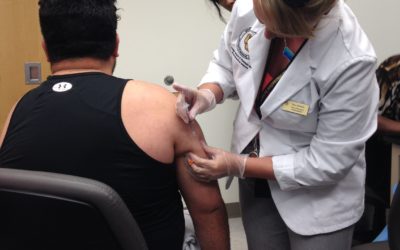For many people, losing the ability to see up close can be a frustrating and concerning part of the aging process. However, this very normal phenomenon can easily be managed using modern day optics. Most will opt for over-the-counter reading glasses, but not everyone wants to be reliant on glasses to navigate their world. For these patients, several options exist including multifocal contacts, monovision, and even some refractive surgery options. Today we will focus on monovision, its pros and cons, and if it may be right for you.
The term monovision lies in the first part of the word, “mono”, which means one. Now this does not mean you’ll only be using one eye; rather one eye at a time for specific tasks. Traditional monovision focuses the dominant eye for the distance. This is the eye the person would use to watch TV and read street signs. The non-dominant or “near” eye is usually focused around where one would naturally hold a book or their phone. Our typical visual setup consists of both eyes focused on the same distance; monovision disrupts that, allowing the patient to effectively have two different focus points simultaneously, without glasses.
See our blog on Double Vision
The pros of monovision are obvious. Patients are able to navigate their world without glasses, seeing clearly at distance and near. This is most often achieved using a single contact lens. Sometimes, a person will still need some kind of correction for their distance eye. In that case, the dominant eye would be corrected for distance, and the other for near.
The cons of monovision are the trickiest to navigate. Not everyone will be a good candidate for this type of correction. This is because monovision breaks down one’s binocular vision. Binocular vision refers to the way our eyes function together, when focused on the same object. Binocular vision is responsible for providing us with not only our clearest vision, but aids our brain’s ability to make sense of space and depth. One-eyed vision still allows for some depth perception, but not nearly as finely tuned as when we have both eyes working together. Those with very sensitive visual systems may struggle with adapting to their eyes not working together. Also, those with specific visual demands, either at distance or near, may find that only using one eye proves difficult or tiresome. However, for the vast majority, after a few months of getting used to the new system, patients tend to adapt and learn to enjoy their new vision and freedom from reading glasses.
If you or someone you know is interested in monovision, the first step would be to visit your eye doctor and discuss your needs. They will be able to determine the dominant eye and appropriate lens strength. I always suggest a patient start with the minimum reading power needed to achieve their goals. Similarly, I recommend wearing the lens at home until they feel comfortable with their new vision prior to driving or participating in activities that require significant visual attention. Monovision can also be achieved surgically, such as with LASIK or cataract surgery. In this case, surgeons will want to ensure this is the right setup for a patient, either by confirming they’ve had it in the past, or by first trialing with a contact lens. For more information, talk to your doctor, and see the links below.
References:
https://www.aao.org/eye-health/treatments/what-is-monovision-blended-vision












